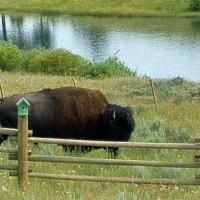
Keeping bison separated from homeowners can help increase tolerance for the big, shaggy mammals.
To that end, four conservation groups have worked together for 10 years to help offset the cost of bison-proof fencing in the Greater Yellowstone Ecosystem. So far the groups have facilitated the construction of fences on 55 properties, an investment of more than $50,000 in coexistence.
“As bison return to portions of their historic range, simple solutions like putting up a fence can help avoid unnecessary conflicts and go a long way in helping communities accept these animals’ presence on the landscape,” said Shana Drimal, wildlife program associate for the Greater Yellowstone Coalition. “A small investment up front can ensure successful coexistence with bison and peace of mind for landowners for years to come.”
The Yellowstone Bison Coexistence Program began in 2011 as a way to increase tolerance for wild bison so they may one day be managed like other wildlife in Montana when roaming outside of Yellowstone National Park.
People are also reading…
Through this program, participating landowners have received technical assistance and a 50% reimbursement — up to $1,000 — to construct fencing to keep bison out of gardens, landscaping, yards, playgrounds, or livestock pastures where they can potentially cause damage or come into conflict with people, pets or livestock.
“The bison fencing program has been great for us since we fenced our trees a few years ago” said Melissa Alder, a resident of West Yellowstone, Montana. “It has allowed us to cultivate several deciduous trees over the years that have been great for birds and viewing a variety of migratory species.”
Keeping residents and bison separate goes a long way to building tolerance for the animals, conservation groups say.
Program participant Ed Ryberg of West Yellowstone, who built a bison-proof fence in 2013 with support from the program, said, “The fence that the bison coexistence program helped us build has been a wonderful improvement, enabling us to enjoy the buffalo while keeping our pets safe and protecting our landscaping.”
Several more fencing projects are being planned for spring.
To keep up with rising costs and demand, the reimbursement cap will move from $1,000 to $1,500 in 2022. Reimbursements exceeding $1,500 may be available for landowners whose livestock or agricultural operations are experiencing frequent or destructive conflicts with bison.
“This program benefits both people and wildlife,” said Amy McNamara, Northern Rockies director for the Natural Resources Defense Council. “Landowners avoid possible property damage and wild bison have more room to roam outside of Yellowstone like other native wildlife. As a result, we help protect this species that has long symbolized our country’s landscape, history and culture.”
The Greater Yellowstone Coalition, Defenders of Wildlife, NRDC and Sierra Club work in partnership with Montana Fish, Wildlife & Parks to offer the program to residents. Prior to this collaboration, landowners did not have access to a program to reimburse them for installing fences to keep bison out.
“The ultimate goal is not just to build fences to keep bison out of trouble, but to build bridges with local communities toward accepting wild bison,” said Russ Talmo, Rockies and Plains representative at Defenders of Wildlife. “That starts by supporting conflict prevention on private lands.”
Get local news delivered to your inbox!
source: https://trib.com/news/state-and-regional/fencing-program-helps-build-tolerance-for-roaming-bison/article_9f91d8d9-f669-5e86-85ed-965e83f9fcf4.html
